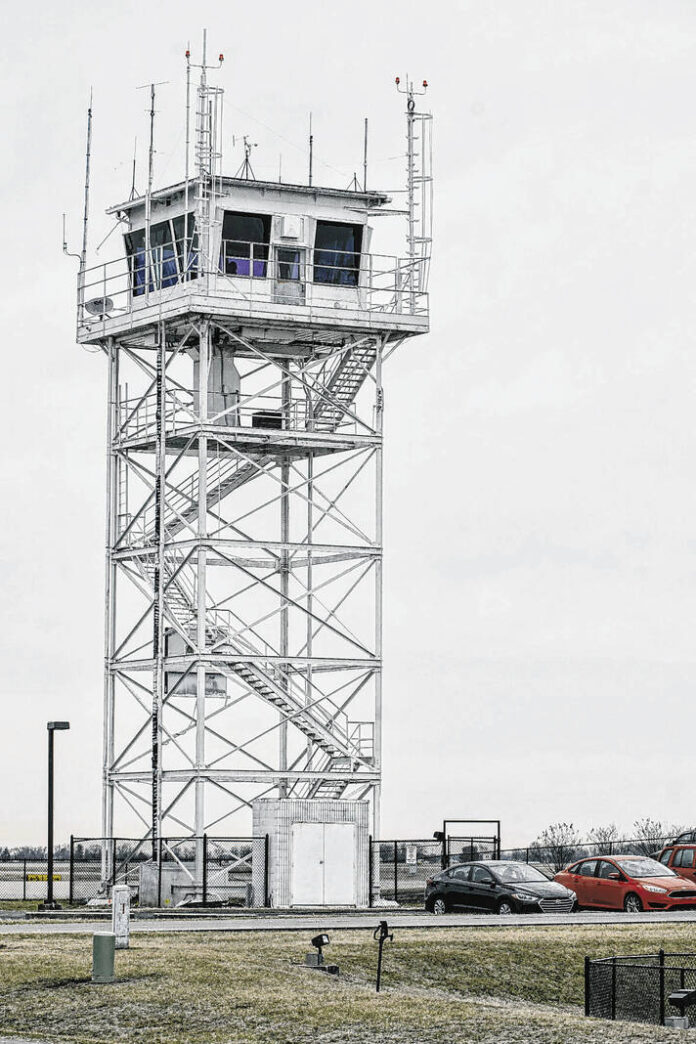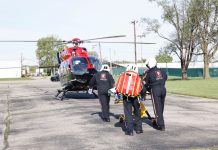
Mike Wolanin | The Republic A view of the control tower at Columbus Municipal Airport in Columbus, Ind., pictured Thursday, Feb. 14, 2019.
Columbus Municipal Airport officials are continuing to look at ways to fund a new control tower, though a recent request for federal funds has come up dry.
“At the end of the day, it wasn’t what we wanted, but we don’t give up easy,” said Airport Director Brian Payne.
The airport had submitted a request for Bipartisan Infrastructure Law (BIL) funding to replace the tower. The original request was about $12 million, but it was lowered to $10 million at the Federal Aviation Administration’s (FAA) request.
According to Payne, $20 million was available across the United States for contract control towers owned by airport sponsors, which is the category the city’s airport falls into. Local airport officials talked with FAA officials from the Chicago Airport District Office and Great Lakes Region about the request and were encouraged by their support.
However, most of the projects that ended up receiving funds from the grant program were those that focused on rehabilitating or upgrading existing towers.
“The FAA came out and instead of awarding new towers and new construction — which is what we all thought the intent of the BIL funding was — they just funded a bunch of repairs across the United States,” said Payne. “So 20 different airports across 18 different states got a small piece of that $20 million funding. So nobody got a new tower anywhere in the United States as part of this funding.”
According to the FAA’s website, a few towers received funds to help with tower relocation or construction, but these were relatively small grants ranging from $500,000 to $1.8 million. In some cases, the project descriptions stated that the funds were just for initial stages such as planning and design.
After the funding awards were announced, Payne again heard from the FAA Chicago Airport District Office and Great Lakes Region, which were also disappointed and surprised by the result.
“We are their number one priority when it comes to funding a new tower infrastructure within that Great Lakes Region,” he said. “They’ve all been to this tower. They’ve all been up in this tower, so we knew that they knew exactly where we were at, from a need standpoint.”
Airport officials have spoken with these individuals about next steps and were encouraged to continue pursuing funds for a new tower. One option discussed is submitting two different requests for the next round of BIL funding: one that covers the full tower, and one that covers only the design portion of the project. That way, if the FAA decides to once again pass on funding a new control tower during the next round, they may at least be willing to fund the design piece.
“The design services are probably $1.5 million, so they’re nothing to sneeze at,” said Payne. “… We need to move the ball forward, right, in some way. And if we can get funding for just the design, it would be at least a step in the right direction. Hopefully that would also allow the FAA to recognize and call upon the importance of our tower just as we start to go through that design process.”
They would then submit additional requests to the FAA in hopes of further funding the project.
In discussing next steps, Payne said the airport hired a firm with connections to FAA’s Washington, D.C. office, and he has a “wrap up meeting” with them to see what else he can learn. The airport is also working on drafting the scope and fees for next steps, looking at initial design, and may also look at the cost and steps for the entire design of the tower.
Funds have been put into the existing tower to keep it in good condition for operations, and officials continue to monitor its status. However, Payne said the airport is “in dire need of a new tower.”
He said in a previous interview that the existing control tower dates back to the 1960s. Although it is still structurally sound and safe for use, there are some accessibility issues, and certain safety items — such as stair tread, height and width — are not up to current standards.
Additionally, a new tower is also needed to support the airport as its operations continue to grow, said Payne. When he stepped into the role of airport director, Columbus Municipal Airport was running 36,000 operations per year. Now, 10 years later, they expect to have about 55,000 operations for 2022.
The main problem with delaying the project, said Payne, is that it increases the cost. A decade ago, airport officials estimated the cost of a new tower at $3 million to $4 million. Their more recent request to the FAA, however, was $10 million (after agreeing to lower it slightly from their initial $12 million ask).
He said that the airport has looked at local opportunities to fund portions of the new tower project, and they could draw small amounts from cash reserves or Tax Increment Financing.
“But at the end of the day, these are hundreds of thousands of dollars, not millions of dollars,” he said. “Unfortunately, without the FAA’s support and funds, we certainly just can’t get to the point we need to get to.”




